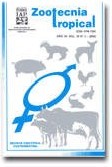
|
Zootecnia Tropical
Instituto Nacional de Investigaciones Agrícolas Venezuela
ISSN: 0798-7269
Vol. 29, No. 1, 2011, pp. 89-102
|
 Bioline Code: zt11008
Bioline Code: zt11008
Full paper language: English
Document type: Research Article
Document available free of charge
|
|
|
Zootecnia Tropical, Vol. 29, No. 1, 2011, pp. 89-102
| es |
Descripción y variación mensual de las etapas reproductivas de la pepitona Arca zebra  (Swainson, 1833) en el banco de Chacopata, península de Araya, estado Sucre, Venezuela (Swainson, 1833) en el banco de Chacopata, península de Araya, estado Sucre, Venezuela
Lista, María; Prieto, Antulio; Velásquez, Carlos; Lodeiros, César; Acosta, Vanessa; Longart, Yelipza & Hernández, Gilma
Resumen
Se estudió la variación mensual (12 meses) de las etapas reproductivas e histológicas en ejemplares adultos de Arca
zebra

, recolectados en el banco natural de Chacopata, estado Sucre, Venezuela. Las características histológicas
del tejido gonadal se describieron en función de los siguientes estadios reproductivos: reposo (0), inicio de
la madurez (I), madurez total (II), desove parcial (III), desove total y degeneración (IV). No se encontraron
diferencias significativas en la proporción total de sexos, aunque este parámetro difirió significativamente de
una relación 1M:1H en algunos meses. La especie presenta asincronía en la maduración de los folículos, sin
embargo, el análisis cuantitativo reveló que los estadios II y III estuvieron presentes durante todo el período de
muestreo. Se observaron los cinco estadios de maduración gonadal en hembras, pero solamente los estadios I al
III en machos. Las frecuencias de los estadios se relacionaron con las variaciones significativas que presentaron
los promedios mensuales del diámetro de los folículos y del lumen en ambos sexos. El diámetro promedio de los
óvulos maduros fue de 6,00 ± 0,11 μm, presentando su máxima proporción en el estadio II. El incremento del
estadio II, observado desde julio hasta septiembre 2002, se correlacionó con aumentos de temperatura, mientras
que el incremento del estadio III coincidió con disminuciones de temperatura observados desde octubre de 2002
hasta enero de 2003. Tanto la salinidad como la concentración de clorofila a mostraron escasa variación durante
el estudio, indicando que no son factores limitantes durante el proceso reproductivo de la especie. Se concluye
que las alteraciones en la temperatura del agua parecen ser el principal factor asociado a las variaciones en el ciclo
reproductivo en A. zebra.
Arca zebra, estadios reproductivos, factores ambientales, maduración sexual
|
| |
| en |
Description and monthly variation in reproductive stages of the clam Arca zebra  (Swainson, 1833) in the Chacopata bank, Araya peninsula, Sucre state, Venezuela (Swainson, 1833) in the Chacopata bank, Araya peninsula, Sucre state, Venezuela
Lista, María; Prieto, Antulio; Velásquez, Carlos; Lodeiros, César; Acosta, Vanessa; Longart, Yelipza & Hernández, Gilma
Abstract
Monthly variation (12 months) in reproductive stages and histology in adult specimens of Arca zebra

harvested
from natural bed of Chacopata, Sucre state, Venezuela were studiedied. The histological characteristics of gonadal
tissue were described according to their reproductive stages: resting (0), onset of maturity (I), total maturity (II),
partial spawning (III), total spawning and degeneration (IV). There were no significant differences in the total
proportion of sexes, although there was significant differences in the 1M:1F relation in some months. The species
presents asynchrony in the maturation of the follicles, however, quantitative analysis shows that while stages II and III were present throughout the sampling period. Males were observed in stages 0 and IV, but in females.
Changes in the frequency of the stages were associated with significant variations presented the monthly mean
diameter of follicles and the lumen in both sexes, were always higher in females. The average diameter of mature
eggs was 5,88 ± 0,11 μm, showing its highest proportion in stage II. The increase in stage II observed from July
to September 2002 was correlated with increases in temperature, while the increase of stage III coincides with
the observed temperature decreases from October 2002 to January 2003. Salinity showed little variation, and the
chlorophyll remained constant during the study, indicating that there is a limiting factor, so it is suggested that
temperature is the main factor associated with reproductive changes in A. zebra.
Arca zebra, reproductive stages, environmental factors, sexual maturation.
|
| |
© Copyright 2011 - Zootecnia Tropical
Alternative site location: http://www.sian.inia.gob.ve/repositorio/revistas_ci/ZootecniaTropical/ztindice.htm
|
|
